![[MetroActive Features]](/gifs/feat468.gif)
[ Features Index | Sonoma County Independent | MetroActive Central | Archives ]
The Road to Burma
Under threat of military reprisals Sebastopol physician Ben Brown and a cadre of colleagues bring medical aid to refugees on the turbulent Thai-Burma border.
By Janet Wells
WE HOP OFF a flatbed truck in the middle of a dusty rutted road in western Thailand, our faces and clothes clogged with the grit of two hours of open-air travel. As our driver lurches up a hill and out of sight, we turn to look at the low rugged hills rising just beyond the banana fields withering in the heat of the dry season: Burma, our destination, although we are far from any official border crossing.
Lugging bags of cucumbers, tomatoes, catfish, and cabbage, we walk a well-worn path through the fields to the banks of the Moie River, where we find two small bamboo rafts waiting to carry us over to one of the refugee camps dotting the Burmese side of the war-torn border. It takes several trips to ferry 10 people and supplies on the rickety rafts, which sink a few inches in the clear green water. On the other side, children and adults, sheltered by umbrellas against the scorching sun, stand silhouetted against the horizon, watching our arrival.
We are not supposed to be here, and I half expect Burmese soldiers to come bursting out of the jungle, waving guns and shouting in a language inscrutable to Western ears. But the camp is quiet, almost motionless during the sweltering midday hours, and I realize that we are not the ones in danger. When the sun goes down, we get to leave, back to where there are no bombs falling, where soldiers aren't burning our homes and fields, where there is enough food and water.
The people here, ethnic Burmese forcibly moved from their villages and relocated to this desolate border camp just a stone's throw from Thailand, have only the luxury of hope.
Sebastopol resident and family-practice physician Ben Brown has been spending his vacations in the battle-scarred villages along the Thai-Burmese border since 1989, when, as a fourth-year medical student, he took off for northern Thailand with the idea of working at one of the refugee camps along the borders of Burma, Laos, and Cambodia. An American doctor sketched a crude map on a napkin, pointing the way to a makeshift refugee medical clinic near Mae Sot, a border town northwest of Bangkok.
Committed and compassionate, with a ribald sense of humor, Ben has a penchant for jumping up onstage to play harmonica or drums. His stories of the Burmese people, the politics, the land are hard to resist. Ben raises thousands of dollars each year for the clinic through his brainchild, the Burmese Refugee Care Project, or BRCP, and when he returns each year to Thailand, he almost always has friends or colleagues in tow.
Veronica Vuksich, a 45-year-old Santa Rosa osteopath and HIV expert, is returning to the clinic for the third time. In 1994, she was part of one of the first mobile medical teams to foray deep into the Burmese jungle to offer treatment in remote villages. Veronica faces more than the usual language barrier of working in an area where little English is spoken. Deaf in one ear and hearing-impaired in another, Veronica relies on lip reading. "But not with the medics here," she says cheerfully. "They have completely different phonetics."
Sebastopol photographer and freelance writer Diana Cushing, 46, has known Ben for 10 years. When Ben hit upon the idea of the Burmese Refugee Care Project, Diana offered to extend the non-profit status of her own group, Arete, which she started in 1984 to help orphaned children in Ethiopia. Diana first visited the clinic last year, and is coming back to write a story, she says, "because I love it here."
Dana Harrison, Berkeley resident and a former Charles Schwab & Co. vice president, is in the enviable position of being retired at age 38.
Ben Brown
Like me, Dana is seeing the clinic and the western border area of Thailand for the first time. It is early March, the beginning of the hot season, and the five of us converge at the Mae Tao Clinic, known to most locals simply as Dr. Cynthia's out of respect for its chief physician Dr. Cynthia Maung. A bustling, ramshackle compound that sees 20,000 patients a year, the clinic offers the only care in the area for refugees, many of them suffering from jungle malaria. More than a few come in with land-mine and shrapnel injuries.
March is the busy time of year along the border, when the military historically steps up its operations against the ethnic Burmese and pro-democracy groups who oppose its rule. Last year and the year before, the Kway Kaloke refugee camp, located in Thailand only a few miles from the clinic, was shelled and burned.
This year, there are rumors of a March 27 onslaught.
Far from the neon and commercialism of Bangkok or the palm-studded beach resorts of the south, Mae Sot is a town with a frontier feel, the Wild West of Thailand. In this border town ripe for smuggling Burmese gems and drugs, the streets teem with a mixture of cultures and races. The town is accessible by tortuous mountain roads or two short flights from Bangkok, which offer aerial views of patchwork fields surrounded by dense hilly jungle. Brilliant green in the wet season, the rice fields now are seared and brown, the air smoky from seasonal burns.
At the outskirts of Mae Sot, we pull up in front of a motley collection of structures and shacks. Most are open-air, the predominant materials bamboo, broad dried leaves, and concrete floors.
Dr. Cynthia Maung's house is at the entrance, the front door seemingly always open, people and dogs lounging around the stoop. There's the old clinic, Ben says, pointing to a large wood house on stilts. Continuing the tour, he points at a thatched roof bungalow: the outpatient clinic. In its three classrooms, the medics conduct immunization, family planning, prenatal, and nutrition sessions. The new inpatient hospital, just completed two weeks ago, much of it funded by BRCP donations, is at the back of the compound. The most high-tech building, the clinic's cinderblock and corrugated-tin-roof hospital boasts 18 plank "beds" with vinyl covers, and IV fluid bags nailed to bamboo poles. There's a volleyball net over hardscrabble dirt, a small store, and, impossibly, it seems, a flower garden thriving in the tropical heat.
The sprawling compound represents a major improvement over the clinic's start in a converted dirt-floor barn with just one medical text. Dr. Cynthia, as everyone calls her, escaped the Burmese capital of Rangoon in 1988 and established the clinic to treat the influx of refugees fleeing Burma's repressive military regime, the State Peace and Development Coalition. Maung intended to leave for 10 days to protest the mass killing of pro-democracy demonstrators, then return to resume her medical practice.
She has not been back since.
We sit in the shade of the quiet outpatient clinic, closed on Sunday, and enjoy the slight breeze that wafts through every so often. Tacked to the split-bamboo screen are sun-faded posters of Burmese democracy leader and Nobel Prize winner Aung San Suu Kyi and the U.N. Bill of Human Rights. Both are ubiquitous in the border area, in guest houses, and in restaurants--and often are the sole decoration in refugee huts.
We ask Ben about cultural no-noes, and he tells us the basics: Don't point your feet at anyone, don't pat babies on the head, don't wear short skirts if you're female, and if you're male, he says, wear the right kind of skirt.
It seems that Ben, eager to fit in with the Burmese men during his first stint at the clinic, decided he would wear a cool saronglike longyi. He bought a subdued grey and black flower-patterned cloth and wrapped it around his waist. "When I came out, one of the medics turned around and literally fell on the ground laughing. He finally managed to squeak out, 'That's, that's a woman's pattern,'" Ben says, laughing at the memory. "Men's longyi are checked. But the Burmese give you a lot of leeway because you're foreign."
Our first stop is the Kway Kaloke camp, where 10,000 refugees make their home in thatched huts on stilts. An estimated 5 million Burmese are refugees of some sort, most of them from the ethnic Karen, Shan, and Mon tribes. Some are displaced within the country, others are living in camps in Thailand as officially registered refugees, many are living in Thailand illegally. Burma--renamed Myanmar by the ruling military--was once a thriving agricultural nation known as the Rice Bowl of Asia. Now, after more than a decade of civil strife, it is one of the 10 least developed nations in the world.
Ben, like most of the several dozen ex-patriots from Europe and America working in the border area with humanitarian aid groups, tries to stay as far away from the convoluted politics of war as possible. "You have to know the politics, but not give it too much weight, because it's depressing," Ben says. "You have to know it so you don't get killed. You don't want to go somewhere that's going to be shelled."
Kway Kaloke, Ben assures us, is safe during the day. But Westerners all leave by sunset because of the nighttime attack strategy of the DKBA, an ethnic Karen splinter group in alliance with the military regime. BRCP donations built the orphanage at Kway Kaloke and provided funds for art classes and a women's sewing project, which was destroyed by shelling last year.
In country: Caught between feuding factions in a bloody civil war, a Burmese family forced to relocate to a refugee camp bides its time (top); Santa Rosa osteopath Veronica Vuksich and Burmese medic Hmo Motin examine a woman at the camp's makeshift clinic (left); a young freedom fighter exhibits his grenade launcher (right).
The camp's Thai police officials, who are watching television in the shade under a hut, allow us in, and we find a lively group of children scissor-kicking over a piece of rope held high by their friends. The kids are barefoot, their faces grimy and clothes stained. They laugh and push each other, every now and then glancing sideways at the tall foreigners clicking pictures.
Ben starts juggling and within seconds is the pied piper of the camp, leading a throng of enthralled boys and girls. He does magic tricks, pulling a coin out of one boy's ear, a red handkerchief out of another's. They chatter and giggle, wide-eyed with surprise as things disappear and reappear. Veronica whips out her video camera and is buried under a swarm of kids eager to see their images on the view screen.
We climb a short bamboo ladder into a hut and greet Hser Paw, daughter of the camp's headman and a resident of the camp since 1984. Wearing a longyi and a blue-striped Nike shirt, she sits on the bamboo slat floor. The roof and walls are made of tightly layered leaves from a teaklike tree. There are two open levels and two small areas sectioned by bamboo screens. There is no furniture; a single door is made of cardboard.
Sweet-voiced, with a luminous smile, 32-year-old Hser Paw struggles with English as she tells the story of running into the fields last year to escape shelling by Burmese troops.
Her mother was hurt by mortar shrapnel, she says, and her family's hut burned to the ground. Their hut burned two years ago as well when soldiers set fire to the camp.
"Every people are frightened that tonight the Burmese will come," she says. "Some children when they hear the noise of bullets, they are shaky. We are afraid. But we have to sleep here. We have to sleep."
Hser Paw translates for her uncle, who displays a poignant faith in international support. "If the United Nations came and took care of us for six months, it will be peaceful in Burma," he says, speaking Karen. "Because the United Nations stands for the whole world."
Cool enough for a blanket during the night, it is already getting hot by 8:30 the next morning. I find Dana walking up the road toward Mae Sot. She is grinning hugely. "Mango and sticky rice," she says, holding out a Styrofoam box procured from a street vendor. "Food orgasm."
The final component of breakfast nirvana, she says, is Thai iced tea at the River House. I follow her into a cozy restaurant that caters to the ex-pats in town: real coffee, classical music, banana pancakes, Bangkok newspapers. No one minds that we brought our own food; they even offer forks to eat the special rice soaked in sweetened coconut milk, covered with succulent mango slices.
This is not Dana's first trip to Thailand, or her first contact with the Burmese. She tells of a 1993 trip to Mae Hong Son, a provincial capital in the north, when she met two young men who said they were Burmese Freedom Fighters. "I asked where they learned such good English, and when they said 'Rangoon University,' I said, like a hostess, 'Oh, how nice! And what are you doing now?' 'Living in the jungle,' they told her, trying to evade capture by military soldiers who, they say, usually work the conscripts to death.
Diana Cushing
"I asked them if they would go for amnesty in the United States, and they said if they did their country would never enjoy the freedoms we have," Dana says. "They were incredibly educated about democratic principles. I felt like I was talking to Patrick Henry and Thomas Jefferson.
"It really struck me," she adds. "I came back to California, and that year there were a lot of those really stupid ballot measures. We have options and freedom and this is what we're doing with it? The contrast was tremendous."
At Maung's house, Diana is compiling a tongue-twisting list of acronyms representing the 30 non-governmental organizations funneling aid to the clinic. Ben suggests unifying groups that are working in the same areas, and Maung reminds him of the politics of humanitarianism. "It's difficult to do it without creating conflicts between governments and the NGOs," she says. "It's better to keep it small and focused."
The heart and soul of the clinic, 39-year-old Maung is seemingly unflappable, even in the midst of endless bureaucracy, sick patients, and visitors all wanting a piece of her time. The clinic is much like a small business, requiring more than $150,000 annually in donations and grants to cover medicine, food, rent, lab tests, orphan care, fees to the Thai hospital in Mae Sot, and training for more than 100 refugee medics. Dressed in a green-striped longyi and white T-shirt, her long black hair in a loose ponytail, Maung sits in her "office"--two chairs and a low table separated from the kitchen by metal filing cabinets and bookcases.
Ben has an almost reverential respect for Maung. "She has a quiet confidence, an unconscious caring. She's like a mother," he says. Ben helped deliver her first child, a boy she named Nein Chan, which means "peace" in Burmese.
Ben almost canceled his trip this year when he heard that Maung was scheduled to travel to the United States in March to meet with congressional and U.N. leaders. He figured he would be needed more as an escort, easing her foray into the international spotlight. But Maung declined the trip, worried that she would not be allowed back into Thailand since she is a Burmese refugee with no passport.
"I want to see other parts of the world," she says, her voice quiet. "But it's risky. And in the dry season on the border, it's more fragile. The fighting has already started inside [Burma]. People in the camps are not secure."
In one of the clinic's bamboo-screened outpatient rooms, Veronica consults with Tamara Horwich, a Columbia University medical student, about a 33-year-old man complaining of pain near his belly button. Tamara feels a mass and wonders if it is some kind of infection.
In the West, says Veronica, doctors would immediately order a blood count, CAT scan, and biopsy. Here the main tools are reasoning skills and experience. Veronica diagnoses a tumor, probably non-Hodgkin's lymphoma, she says. There is no radiation treatment available, so Veronica, with medic Ah Mang translating, explains the condition and answers questions.
"It's frustrating sometimes not to be able to give the standard of care [we're used to in the West]," she says. "But we can help them understand what's going on and what to expect."
Veronica sees patients and helps train the medics in everything from rashes and HIV to diarrhea and nutrition. While the clinic has little in the way of technology, there's a sense of freedom, she says, that Western medicine lacks. "This isn't diluted with insurance forms, legal ramifications. "There's not a lot of bureaucratic overlay. It's very rewarding," she says. "This is where I can practice real medicine."
In the cool of the morning we leave the clinic for the refugee camp inside Burma, standing in the truck for much of the two-hour drive. The camp has grown from 200 to 4,500 residents in less than a year. The residents were forced from their homes, but, unlike Burmese refugees in Thailand, they are allowed to walk back to their villages during the day to tend their coconut and mango trees and animals.
Juggling act: Ben Brown entertains children at the camp.
We cross the Moie River and carry food supplies up to the camp clinic, a single bamboo hut next to a field charred and ashy from recent clearing.
We walk up a scrub-covered hill to the camp's church-funded school, where the students sing Christian hymns in Burmese. One young boy proudly recites the ABCs for us. Although teaching any language but Burmese in the camp schools is prohibited, students learn a smattering of English, Thai, and Karen. In the distance we hear the sound of drums and cymbals, and catch a glimpse of a colorful parade through trees thick with dust.
Four youngsters, dressed in lace and sequins and gold-trimmed finery, their faces rouged and powdered and shaved heads covered by ornate flowered headdresses, are re-enacting the legend of Siddhartha giving up the riches of royalty.
It is an annual rite of passage for Burmese boys who choose to become Buddhist. Men carry the boys on their shoulders, and a crowd of musicians and well-wishers holding bright umbrellas against the afternoon sun weaves through the camp to a make-shift temple in one of the huts. The boys, dark-eyed and solemn, sit above everyone, drinking juice. The symbolism of sacrifice seems almost jarring in a place where most families have little more than one pot for cooking.
After a traditional Burmese lunch of jungle vines, catfish, and vegetables in an oily curry paste, I walk toward the creek, trying in vain to find a pair of elephants spotted earlier in the fields.
"What's so incredible is the amount of suffering all these people have gone through," says Diana, returning from a picture-taking foray. "I look around the camp and think, wow, I can take great photos, it's beautiful. But their lives have been blown apart.
"My son gets freaked if he has a bad dream or sees a weird movie. These kids are living a weird movie," she says. Even in the shade with the creek burbling nearby, the air is hot and close, smelling of smoke and sun-baked dirt. Three men work in the sun to fix a waterpipe snaking from the creek to a newly tilled field. "People can go through so much and still smile. You see the depths of the human will come forth," Diana says.
She muses about returning to Sebastopol in less than a week, to the comfort of her own car, her own house, her family. "The hardest thing about coming back to Sonoma County is how isolated people are," she says. "It will feel strange to go to Food for Thought, where you roll your little cart down the aisle, instead of the open market where people are wearing colorful clothes, bumping into you, spitting, saying hi.
"It's important to get out of the bubble in California and wake up to what's happening in the world," Diana adds. "Burma is not the only place. There are so many places that have their own unique version of the same situation."
On the ride home, we all lie down in the truck bed, drained by the day's heat. Our driver stops to pick up a Thai soldier, and I learn from Ben that our access to the camp is no accident: Maung's supporters cultivate friendships with Thai authorities. The Thais officially are neutral in the conflict between the Burmese military, the pro-democracy forces, and the ethnic tribes. Wanting to remain on peaceful terms with their neighbor, Thai officials have done little to stop forced relocations or attacks on refugee camps even in Thailand. Many refugees live in fear of being deported.
Ben talks quietly about the day at the camp and about his past trips to the clinic. The sun slowly sinks, a golden glow reflected in the roadside jungle and fields. "There's always a lesson for me," he says, his voice mellow and sleepy. "I'm never sure what it's going to be."
The next morning I see Dana at the River House, looking very glum. "I had a little situation last night," she says, leaning forward. "But I don't want to talk about it here."
We finish breakfast and walk toward the town's open market. She explains that she had gone out late in the evening to buy a soda, and started talking to a man in his 50s who spoke excellent English. "He invited me to sit, and I said that I didn't want to sit because I had been on a long truck ride. He said, 'Oh, a long truck ride? Where to?' When I told him about going into Burma, he proceeded to basically grill me."
Who was she with, what did she see, how many in the group, what were the names of the camp's teachers, the man asked. "I'm such an American, I was, like, 'Blah, blah, blah.'"
When the man mentioned that he was a businessman from Myanmar, Dana's guard went up. "No single other person that we've run into has said 'Myanmar.' I started being vague, and got the hell out of there. The good news is that I didn't mention Maung, Ben, any names of organizations," she adds. "But I did mention the name of the camp, the school, and that they teach Thai, Burmese, Karen, and English. He was all over that."
Ben had Dana re-create the entire conversation late that night. "This is not good," he told her.
Diana Cushing
"He didn't pretend to be Karen, so he's probably not a Burmese secret agent, but he's probably high up, and there's a likelihood of him going and telling someone that there's an American group that went into the camp," Dana says. "I just feel so stupid."
Ben tells Dana that his cover story when visiting Mae Sot is tourist-trekking to border waterfalls and seeing friends. For fear of reprisals, he asks me not to print the name of the refugee camp in Burma or the last names of many of the refugees.
"He felt badly that he didn't warn us more," Dana says. "His advice is to treat this as though you were in a spy movie.
"This is a war zone."
My last night in town we go to Crocodile Tears, where the Thai owner plays American cover songs on the guitar. "This place is like Mae Sot's Cheers," says Ben, waving at a group of ex-pats coming in the door. "You walk in and everyone's like, 'Hey! Hi!'" The owner's wife starts playing a large table dulcimer called a Crocodile, the bar's namesake. Haunting and rollicking at the same time, the music gets everyone clapping and makes me feel good and a bit melancholy, as if there's a sad story under the chords.
An apt ending to our sojourn to the Burma border, I think, as we all raise our glasses in a toast.
Back in Sebastopol three weeks later, we sit around Ben's kitchen table, looking at Diana's photographs. In between bites of stir-fry noodles and tofu, Ben brings us up to date. March passed with no military action, he says. And the BRCP raised an unprecedented $43,000 just in the month he was in Mae Sot.
A man from Boston, who had read about the BRCP on the Internet, showed up with an astounding $10,000 in cash, and some travelers from Oakland who were in the area looking at Burmese antiques dropped by the clinic and plunked down $400.
Then a couple from the East Bay, who are longtime BRCP donors, made their first trip to the clinic. Ben gave them the grand tour, showing them the new hospital, taking them to Kway Kaloke camp, and to a special Burmese dinner.
Dana put together a funding proposal totaling $33,000 for a new computer for the mobile medics program, a microscope for a satellite medical clinic, and two years' salary for an administrator. "We thought they'd fund just one project," says Ben. "They funded all."
As always, Ben says, he receives more than he gives on his trips to the border. "I've only been back a week," he says, blue eyes shining as he looks out the window at sheep roaming in a neighbor's pasture. "But everything here is so much easier than when I left. I'm feeling a lot of gratitude for simple things--a hot shower, a bed, being able to cook in my kitchen, and having a sink. It's a real comfort and ease with what I have.
"That's a gift."
Owing to the threat of police retaliation, the exact location of the refugee camp has not been disclosed.
[ Sonoma County | MetroActive Central | Archives ]
Copyright © Metro Publishing Inc. Maintained by Boulevards New Media.
![]()
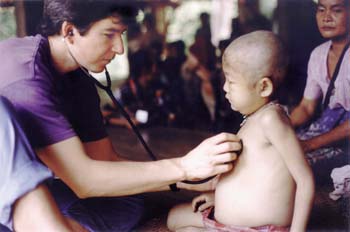
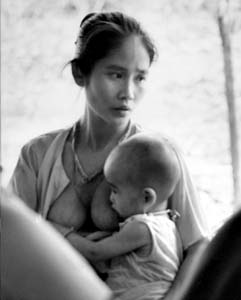 Family portrait: A young Burmese mother cradles her sick child, weakened by measles and malnourishment, while waiting at the camp clinic.
Family portrait: A young Burmese mother cradles her sick child, weakened by measles and malnourishment, while waiting at the camp clinic.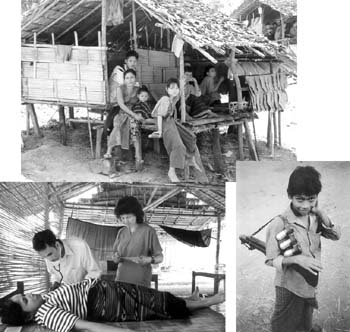
Diana Cushing (top and left) and Ben Brown (right)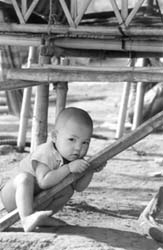 Sanctuary: A little boy, one of an estimated 5 million refugees displaced by the civil war, seeks shelter in the shade of a camp hut.
Sanctuary: A little boy, one of an estimated 5 million refugees displaced by the civil war, seeks shelter in the shade of a camp hut.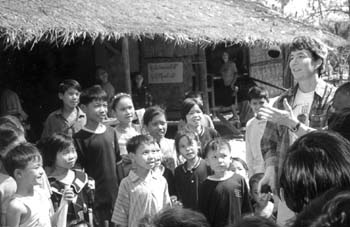
Janet Wells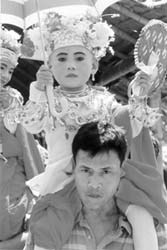 Rite of passage: Camp children celebrate their coming of age.
Rite of passage: Camp children celebrate their coming of age.
Dr. Ben Brown will host a slide show to benefit the Burmese Refugee Care Project on Thursday, April 29, at 7, at the Luther Burbank Center. For more information, call 522-9701, e-mail [email protected], or check the BRCP website.
From the April 15-21, 1999 issue of the Sonoma County Independent.